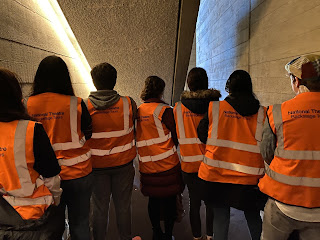A later start on the itinerary provided students the opportunity to partake in some London sightseeing! The Queen was awaiting the students as they arrived via tube at Buckingham Palace. The Royal Standard flew high, along with maximum security and a noisy helicopter. The students grasped the opportunity to take some photographs at the regal venue. Next, a scenic walk to the Westminster Abby, Big Ben of the Elizabeth Tower and the Parliament Buildings. Unfortunately, ‘Big Ben,’ wasn’t visible due to scaffolding, however, still a beautiful region to collect more treasured photographs. A cross over the River Thames led the students past the London Eye before heading to the National Theatre on Southbank.
First up at the National Theatre was a backstage tour. A valuable experience that provided insight into the vast variety of employees working for the National Theatre, from carpenters, costume and prop designers, lifting teams, lighting and sound designers, front office, management and to the actors themselves, it was a fantastic tour. The entire National Theatre venue is modern, with every component having a distinct and purposeful role. After a quick stop for lunch, the students took their seats for the first show, ‘Translations,’ in the main theatre, the Olivier Theatre.
Modelled on the Greek Theatre, Epidaurus, an open community style theatre was developed with a circular Thrust stage. This decision allowed the actors to connect more personally with all of the audience members who are seated in a tiered ‘fan’ shape. The stage has been built at the very top of the building, with a specially designed lift that connects all the way down to the base of the venue. As an audience, you could see members of the cast entering over the back of the stage, which appeared from the audience to be a ‘drop’ into the abyss! Steps leading down to an exit created an optical illusion of an ‘outdoor’ theatre space - as with Greek Amphitheatre. A fantastic design that allowed for unique and effective entry to stage without the ‘wings’ of a more traditional Proscenium theatre space. ‘Translations,’ a famous Irish play, studied by students across Britain, is set in rural Ireland in the 1800s at the time British settlers overtook and renamed parts of Ireland, forbidding Gaelic language and forming an English map. This is a play that communicates the ‘death’ of identity and that of culture in an underlying message. The National Theatre used a live orchestra for atmospheric music and sound effects throughout the performance. The set was intricate, but raw, creating the effect of mud flats and a concrete square that represented the minimalist time and place of an old hedge-school. An outstanding show that was appreciate by all.
The final show, ‘The Three Sisters,’ was performed in the Lyttleton Theatre. It was a contemporary reworking of Chekhov’s famous play with the setting, Lagos instead of Moscow. It was very comic in the first half and increasingly tragic in the second half as the lives of the four siblings unravel due to political unrest and internal family disintegration. The timeless story of a family who live buried in the country and long to return to their former life in a big cosmopolitan city resonates with everyone who lives in a small place.
















Comments
Post a Comment